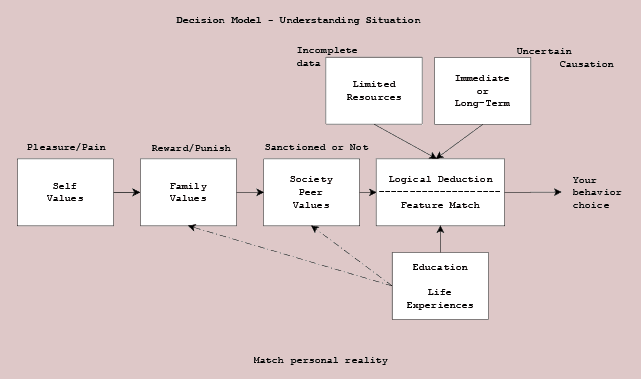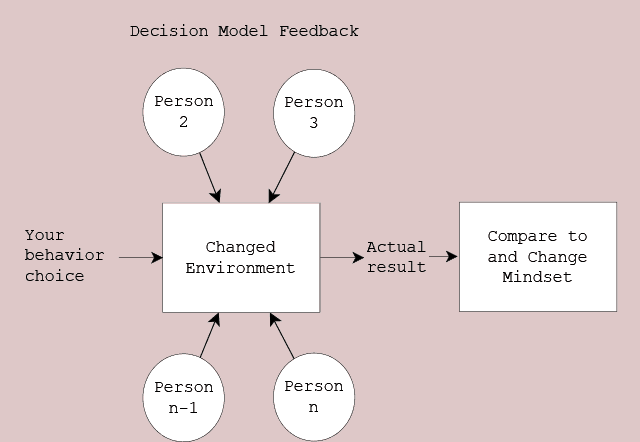The Decision Model condenses the architecture of our behavioral decision-making. Even when we are adults, the vestiges of our march through developmental steps form the base of each succeeding step in the decision process. That is, rational thought cultivated as an adult cannot always triumph over the groundwork of moral codes and world presumptions that we learned as infants, tykes, youths, teenagers, and young adults.
Decision Model
The decision model is sufficiently complex that I have divided it in two parts, the understanding of the situation leading to one’s choice (Figure 24.1) and the feedback and response to the choice (Figure 24.2)

Decision Model Choice
- Starting at the far left of Figure 24.1 are the values of pleasure and pain which we learned and which exclusively guided our behavior when we were infants.
- As we learned language and the values in our family, our personal values were often trumped by rewards and punishments for our behavioral choices.
- Once we were old enough for school and neighborhood friendships, we discovered that our family values were not sacrosanct. Away from home, our choices had a greater latitude. Our peers and society greeted these behaviors with approval and perhaps disapproval.
- As we reached greater cognitive capacity, we applied reasoning on a situation about which we had limited information, uncertain grasp of linkages between events, and the speed at which we needed to make our response. Reasoning has two separate forms–logic and association–which swap their results with one another.
- As our personal experience widened, our peers related their experiences, and schooling taught us further relationships, our suppleness in handling situation grew.
- Some situations require immediate actions, like sports and safety, with immediate consequences. Others are long-term, requiring much effort and time, to achieve the end result. The assessment of this urgency and the need for immediate gratification is grounded in the first three steps of this process.
Decision Model Feedback

Our behaviors and their consequences also affect our mindset. Figure 24.2 presents the gist of the sometimes complicated internal changes.
- When we chose a behavior, we have a particular expectation of the result, the change to our environment.
- However, in addition to any mistakes we may have in our thoughts, other people (here numbered 2,3,…, n1-, and n) are also acting in that same environment, according to their own needs, desires, and fears.
- The result of our action combines with everyone’s actions to change the situation. Perhaps we attain our desire. Perhaps not.
- We compare the actual result against our intention. We may have an epiphany or we may realize that certain acquaintances have worked against our desire or that general beliefs we learned in school or from the media do not work in our world. If so, our internal beliefs about the world shift.
- If mindset changes are made, they become the new base for the next situation we face.
Further discussion of knowledge and learning start in: